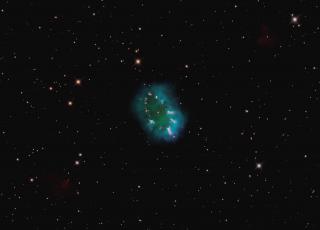Bibcode
Guzman-Ramirez, L.; Lagadec, E.; Wesson, R.; Zijlstra, A. A.; Müller, A.; Jones, D.; Boffin, H. M. J.; Sloan, G. C.; Redman, M. P.; Smette, A.; Karakas, A. I.; Nyman, Lars-Åke
Referencia bibliográfica
Monthly Notices of the Royal Astronomical Society: Letters, Volume 451, Issue 1, p.L1-L5
Fecha de publicación:
7
2015
Número de citas
22
Número de citas referidas
16
Descripción
During the late stages of their evolution, Sun-like stars bring the
products of nuclear burning to the surface. Most of the carbon in the
Universe is believed to originate from stars with masses up to a few
solar masses. Although there is a chemical dichotomy between oxygen-rich
and carbon-rich evolved stars, the dredge-up itself has never been
directly observed. In the last three decades, however, a few stars have
been shown to display both carbon- and oxygen-rich material in their
circumstellar envelopes. Two models have been proposed to explain this
dual chemistry: one postulates that a recent dredge-up of carbon
produced by nucleosynthesis inside the star during the Asymptotic Giant
Branch changed the surface chemistry of the star. The other model
postulates that oxygen-rich material exists in stable keplerian rotation
around the central star. The two models make contradictory, testable,
predictions on the location of the oxygen-rich material, either located
further from the star than the carbon-rich gas, or very close to the
star in a stable disc. Using the Faint Object InfraRed CAmera (FORCAST)
instrument on board the Stratospheric Observatory for Infrared Astronomy
(SOFIA) Telescope, we obtained images of the carbon-rich planetary
nebula BD +30° 3639 which trace both carbon-rich polycyclic aromatic
hydrocarbons and oxygen-rich silicate dust. With the superior spectral
coverage of SOFIA, and using a 3D photoionization and dust radiative
transfer model we prove that the O-rich material is distributed in a
shell in the outer parts of the nebula, while the C-rich material is
located in the inner parts of the nebula. These observations combined
with the model, suggest a recent change in stellar surface composition
for the double chemistry in this object. This is evidence for dredge-up
occurring ˜103 yr ago.
Proyectos relacionados

Nebulosas Bipolares
Nuestro proyecto persigue tres objetivos principales: 1) Determinar las condiciones físico-químicas de las nebulosas planetarias con geometría bipolar y de las nebulosas alrededor de estrellas simbióticas. El fin es entender el origen de la bipolaridad y poner a prueba los modelos teóricos que intentan explicar la morfología y la cinemática nebular
Antonio
Mampaso Recio